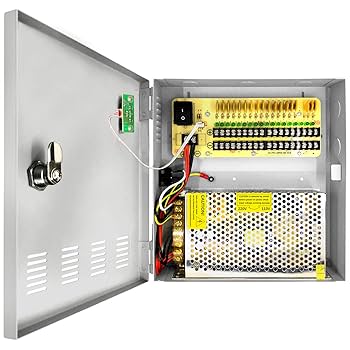Security cameras help keep homes and businesses safe. But to work well, these cameras need power. Without power, security cameras cannot record or show images. This is why choosing the right security camera power supply is very important.
What Is a Security Camera Power Supply?
A security camera power supply is the source of energy for the camera. It provides the electricity needed to make the camera work. The power supply can be a battery, a plug-in adapter, or a special device called a power over Ethernet (PoE) injector. Each type has different uses and benefits.
Types of Power Supplies for Security Cameras
There are three common types of power supplies for security cameras:
- Battery Power
- AC/DC Adapters
- Power over Ethernet (PoE)
Battery Power
Battery power means the camera uses batteries to run. This type is easy to install because no wires are needed. It is good for places where it is hard to get electricity. But batteries can run out fast, so they need to be changed or charged often.
Ac/dc Adapters
Most security cameras use AC/DC adapters. These adapters plug into a wall outlet. They change the electricity from the outlet to a safe voltage for the camera. This power supply is steady, so the camera works all the time without interruption.
Power Over Ethernet (poe)
PoE is a smart way to power cameras. It uses one cable to send both power and data. This means fewer wires and easier setup. PoE is common in big security systems. It also helps protect the camera from power problems.

Credit: www.amazon.com

Credit: www.amazon.com
Why Is the Power Supply Important?
The power supply is the heart of a security camera system. Here are some reasons why it matters:
- Continuous Operation: The camera needs constant power to record and send images.
- Safe Voltage: The power supply gives the right voltage. Too much or too little voltage can harm the camera.
- Reliable Performance: A good power supply keeps the camera running even during power changes.
Choosing the Right Power Supply
Picking the right power supply depends on your needs. Here are some things to think about:
| Factor | What to Consider |
|---|---|
| Camera Type | Check what power the camera needs. Some cameras need 12V, others 24V. |
| Power Source | Decide if you want battery, plug-in, or PoE power. |
| Distance | Long cable runs may need special power solutions to avoid power loss. |
| Weather | Outdoor cameras need weatherproof power supplies. |
| Backup Power | Consider batteries or UPS for power cuts. |
Voltage and Current: What Do They Mean?
Voltage and current are important for power supply. Voltage is the pressure pushing electricity. Current is the flow of electricity. Cameras need a certain voltage and current to work well.
Most security cameras use 12 volts. Some may need 24 volts. The power supply must match the camera’s voltage. If not, the camera might not work or could get damaged.
Current is measured in amps or milliamps. The power supply must provide enough current. If the current is too low, the camera may turn off or work badly.
Power Supply Connectors
Power supply connectors attach the power source to the camera. The most common types are:
- Barrel Connectors: Round plugs that fit the camera’s power jack.
- Terminal Blocks: Used for hard-wiring power cables.
- PoE Connectors: Use Ethernet cables for power and data.
Make sure the connector fits your camera. A wrong connector can cause power problems.
How to Install a Security Camera Power Supply
Installing the power supply is simple but needs care. Follow these steps:
- Turn off the power before working with wires.
- Check the camera’s power needs in the manual.
- Choose the right power supply and connector.
- Connect the power supply to the camera.
- Plug the power supply into a wall outlet or battery.
- Turn on the power and test the camera.
Common Problems with Power Supplies
Sometimes, power supplies cause problems. Here are common issues:
- Power Loss: The camera turns off or reboots.
- Voltage Drop: The voltage is too low at the camera.
- Overheating: Power supply gets very hot.
- Wrong Connector: Power does not reach the camera.
If you face any problem, check the power supply and cables first.
Tips for a Good Power Supply Setup
- Use power supplies from trusted brands.
- Keep power cables away from water and heat.
- Use weatherproof power supplies for outdoor cameras.
- Use a surge protector to avoid damage from power spikes.
- Label cables to avoid confusion during maintenance.
Backup Power for Security Cameras
Power cuts can stop security cameras. Backup power keeps cameras running during outages. Some options are:
- Battery Backup: Batteries provide power when the main source fails.
- Uninterruptible Power Supply (UPS): Keeps power flowing for a short time.
- Solar Power: Solar panels charge batteries to power cameras.
Backup power adds safety and peace of mind.
Frequently Asked Questions
What Type Of Power Supply Do Security Cameras Use?
Most security cameras use 12V or 24V DC power supplies for stable operation.
Can Security Cameras Work With Batteries Only?
Yes, some cameras run on batteries but need frequent recharging or replacement.
How Long Does A Security Camera Power Supply Last?
A good power supply can last several years with proper care and no damage.
Is It Safe To Use Any Power Adapter For Cameras?
Using the wrong adapter can damage your camera; use the recommended voltage and current.
Conclusion
The security camera power supply is a key part of any camera system. It gives the energy to keep cameras working all the time. Choose the right power supply for your camera’s needs. Remember to check voltage, current, and connector type. Use backup power to avoid losing video during outages.
Good power supply means your security cameras will help protect your home or business reliably.